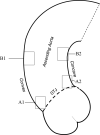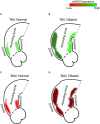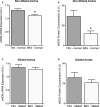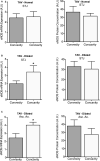Dysregulation of Endothelial Nitric Oxide Synthase Does Not Depend on Hemodynamic Alterations in Bicuspid Aortic Valve Aortopathy
- PMID: 32873108
- PMCID: PMC7726972
- DOI: 10.1161/JAHA.120.016471
Dysregulation of Endothelial Nitric Oxide Synthase Does Not Depend on Hemodynamic Alterations in Bicuspid Aortic Valve Aortopathy
Abstract
Background Bicuspid aortic valves (BAVs) predispose to ascending aortic aneurysm. Turbulent blood flow and genetic factors have been proposed as underlying mechanisms. Endothelial nitric oxide synthase (eNOS) has been implicated in BAV aortopathy, and its expression is regulated by wall shear stress. We hypothesized that if turbulent flow induces aneurysm formation in patients with a BAV, regional differences in eNOS expression would be observed in BAVs. Methods and Results Ascending aortic specimens were harvested intraoperatively from 48 patients with tricuspid aortic valve (19 dilated, 29 nondilated) and 38 with BAV (28 dilated, 10 nondilated) undergoing cardiac surgery. eNOS mRNA and protein concentration were analyzed at the convex and concave aortic wall. In nondilated aortas, eNOS mRNA and protein concentration were decreased in BAV compared with tricuspid aortic valve (all P<0.05). eNOS expression was increased in association with dilation in BAV aortas (P=0.03), but not in tricuspid aortic valve aortas (P=0.63). There were no regional differences in eNOS mRNA or protein concentration in BAV aortas (all P>0.05). However, eNOS expression was increased at the concave wall (versus convexity) in tricuspid aortic valve dilated aortas (all P<0.05). Conclusions Dysregulated eNOS occurs independent of dilation in BAV aortas, suggesting a potential role for aberrantly regulated eNOS expression in the development of BAV-associated aneurysms. The absence of regional variations of eNOS expression suggests that eNOS dysregulation in BAV aortas is the result of underlying genetic factors associated with BAV disease, rather than changes stimulated by hemodynamic alterations. These findings provide insight into the underlying mechanisms of aortic dilation in patients with a BAV.
Keywords: aortic valve; ascending aortic aneurysm; bicuspid aortic valve; endothelial nitric oxide synthase; hemodynamics.
Conflict of interest statement
None.
Figures






Similar articles
-
Endothelial nitric oxide synthase alterations are independent of turbulence in the aorta of patients with a unicuspid aortic valve.JTCVS Open. 2021 Aug 21;8:157-169. doi: 10.1016/j.xjon.2021.08.018. eCollection 2021 Dec. JTCVS Open. 2021. PMID: 36004114 Free PMC article.
-
Regional Disruptions in Endothelial Nitric Oxide Pathway Associated With Bicuspid Aortic Valve.Ann Thorac Surg. 2016 Oct;102(4):1274-81. doi: 10.1016/j.athoracsur.2016.04.001. Epub 2016 Jun 7. Ann Thorac Surg. 2016. PMID: 27283108 Free PMC article.
-
Smooth muscle cell phenotypic switching occurs independent of aortic dilation in bicuspid aortic valve-associated ascending aortas.PLoS One. 2024 Jul 2;19(7):e0306515. doi: 10.1371/journal.pone.0306515. eCollection 2024. PLoS One. 2024. PMID: 38954721 Free PMC article.
-
Bicuspid Aortic Valves: an Up-to-Date Review on Genetics, Natural History, and Management.Curr Cardiol Rep. 2022 Aug;24(8):1021-1030. doi: 10.1007/s11886-022-01716-2. Epub 2022 Jul 22. Curr Cardiol Rep. 2022. PMID: 35867195 Review.
-
Multimodality imaging in bicuspid aortic valve.Prog Cardiovasc Dis. 2020 Jul-Aug;63(4):442-451. doi: 10.1016/j.pcad.2020.06.003. Epub 2020 Jun 9. Prog Cardiovasc Dis. 2020. PMID: 32531300 Review.
Cited by
-
Commentary: How form and function of the aortic valve influence the proximal aorta.JTCVS Open. 2021 Oct 29;8:175-176. doi: 10.1016/j.xjon.2021.10.032. eCollection 2021 Dec. JTCVS Open. 2021. PMID: 36004062 Free PMC article. No abstract available.
-
Endothelial nitric oxide synthase alterations are independent of turbulence in the aorta of patients with a unicuspid aortic valve.JTCVS Open. 2021 Aug 21;8:157-169. doi: 10.1016/j.xjon.2021.08.018. eCollection 2021 Dec. JTCVS Open. 2021. PMID: 36004114 Free PMC article.
-
SMAD3 contributes to ascending aortic dilatation independent of transforming growth factor-beta in bicuspid and unicuspid aortic valve disease.Sci Rep. 2022 Sep 14;12(1):15476. doi: 10.1038/s41598-022-19335-w. Sci Rep. 2022. PMID: 36104385 Free PMC article.
-
Clinical implications of the biomechanics of bicuspid aortic valve and bicuspid aortopathy.Front Cardiovasc Med. 2022 Aug 12;9:922353. doi: 10.3389/fcvm.2022.922353. eCollection 2022. Front Cardiovasc Med. 2022. PMID: 36035900 Free PMC article. Review.
-
Update in Biomolecular and Genetic Bases of Bicuspid Aortopathy.Int J Mol Sci. 2021 May 27;22(11):5694. doi: 10.3390/ijms22115694. Int J Mol Sci. 2021. PMID: 34071740 Free PMC article. Review.
References
-
- Fedak PW, Verma S, David TE, Leask RL, Weisel RD, Butany J. Clinical and pathophysiological implications of a bicuspid aortic valve. Circulation. 2002;106:900–904. - PubMed
-
- Siu SC, Silversides CK. Bicuspid aortic valve disease. J Am Coll Cardiol. 2010;55:2789–2800. - PubMed
-
- Basso C, Boschello M, Perrone C, Mecenero A, Cera A, Bicego D, Thiene G, De Dominicis E. An echocardiographic survey of primary school children for bicuspid aortic valve. Am J Cardiol. 2004;93:661–663. - PubMed
-
- Carro A, Teixido‐Tura G, Evangelista A. Aortic dilatation in bicuspid aortic valve disease. Rev Esp Cardiol (Engl Ed). 2012;65:977–981. - PubMed
-
- Girdauskas E, Borger MA, Secknus MA, Girdauskas G, Kuntze T. Is aortopathy in bicuspid aortic valve disease a congenital defect or a result of abnormal hemodynamics? A critical reappraisal of a one‐sided argument. Europ J Cardio‐Thoracic Surg. 2011;39:809–814. - PubMed
Publication types
MeSH terms
Substances
LinkOut - more resources
Full Text Sources

